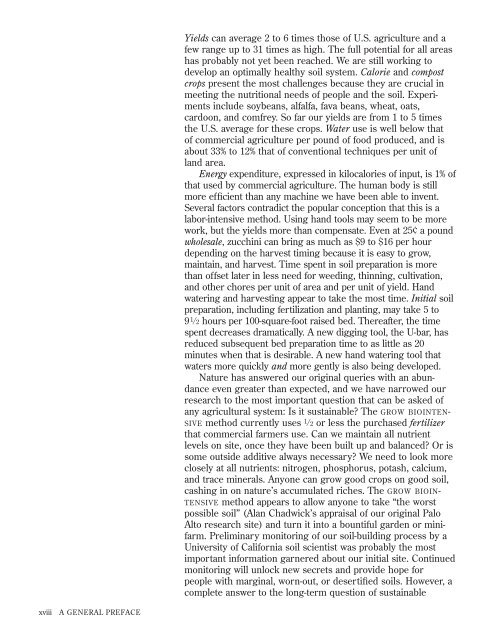How to Grow More Vegetables : And Fruits, Nuts ... - Shroomery
How to Grow More Vegetables : And Fruits, Nuts ... - Shroomery
How to Grow More Vegetables : And Fruits, Nuts ... - Shroomery
Create successful ePaper yourself
Turn your PDF publications into a flip-book with our unique Google optimized e-Paper software.
xviii A GENERAL PREFACE<br />
Yields can average 2 <strong>to</strong> 6 times those of U.S. agriculture and a<br />
few range up <strong>to</strong> 31 times as high. The full potential for all areas<br />
has probably not yet been reached. We are still working <strong>to</strong><br />
develop an optimally healthy soil system. Calorie and compost<br />
crops present the most challenges because they are crucial in<br />
meeting the nutritional needs of people and the soil. Experiments<br />
include soybeans, alfalfa, fava beans, wheat, oats,<br />
cardoon, and comfrey. So far our yields are from 1 <strong>to</strong> 5 times<br />
the U.S. average for these crops. Water use is well below that<br />
of commercial agriculture per pound of food produced, and is<br />
about 33% <strong>to</strong> 12% that of conventional techniques per unit of<br />
land area.<br />
Energy expenditure, expressed in kilocalories of input, is 1% of<br />
that used by commercial agriculture. The human body is still<br />
more efficient than any machine we have been able <strong>to</strong> invent.<br />
Several fac<strong>to</strong>rs contradict the popular conception that this is a<br />
labor-intensive method. Using hand <strong>to</strong>ols may seem <strong>to</strong> be more<br />
work, but the yields more than compensate. Even at 25¢ a pound<br />
wholesale, zucchini can bring as much as $9 <strong>to</strong> $16 per hour<br />
depending on the harvest timing because it is easy <strong>to</strong> grow,<br />
maintain, and harvest. Time spent in soil preparation is more<br />
than offset later in less need for weeding, thinning, cultivation,<br />
and other chores per unit of area and per unit of yield. Hand<br />
watering and harvesting appear <strong>to</strong> take the most time. Initial soil<br />
preparation, including fertilization and planting, may take 5 <strong>to</strong><br />
9 1 ⁄ 2 hours per 100-square-foot raised bed. Thereafter, the time<br />
spent decreases dramatically. A new digging <strong>to</strong>ol, the U-bar, has<br />
reduced subsequent bed preparation time <strong>to</strong> as little as 20<br />
minutes when that is desirable. A new hand watering <strong>to</strong>ol that<br />
waters more quickly and more gently is also being developed.<br />
Nature has answered our original queries with an abundance<br />
even greater than expected, and we have narrowed our<br />
research <strong>to</strong> the most important question that can be asked of<br />
any agricultural system: Is it sustainable? The GROW BIOINTEN-<br />
SIVE method currently uses 1 ⁄ 2 or less the purchased fertilizer<br />
that commercial farmers use. Can we maintain all nutrient<br />
levels on site, once they have been built up and balanced? Or is<br />
some outside additive always necessary? We need <strong>to</strong> look more<br />
closely at all nutrients: nitrogen, phosphorus, potash, calcium,<br />
and trace minerals. Anyone can grow good crops on good soil,<br />
cashing in on nature’s accumulated riches. The GROW BIOIN-<br />
TENSIVE method appears <strong>to</strong> allow anyone <strong>to</strong> take “the worst<br />
possible soil” (Alan Chadwick’s appraisal of our original Palo<br />
Al<strong>to</strong> research site) and turn it in<strong>to</strong> a bountiful garden or minifarm.<br />
Preliminary moni<strong>to</strong>ring of our soil-building process by a<br />
University of California soil scientist was probably the most<br />
important information garnered about our initial site. Continued<br />
moni<strong>to</strong>ring will unlock new secrets and provide hope for<br />
people with marginal, worn-out, or desertified soils. <strong>How</strong>ever, a<br />
complete answer <strong>to</strong> the long-term question of sustainable












